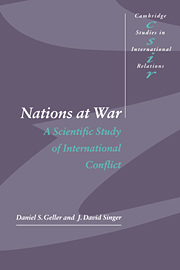Book contents
- Frontmatter
- Contents
- List of figures and tables
- Acknowledgements
- Introduction
- 1 Overview
- 2 Decision models
- 3 War-prone states
- 4 War-prone dyads
- 5 War-prone regions
- 6 War-prone systems
- 7 Case study: Iran/Iraq War (1980)
- 8 Case study: World War I (1914)
- 9 Conclusion
- Appendix 1 List of databases
- Appendix 2 Tables of references by category
- References
- Index
- Cambridge Studies in International Relations
2 - Decision models
Published online by Cambridge University Press: 16 October 2009
- Frontmatter
- Contents
- List of figures and tables
- Acknowledgements
- Introduction
- 1 Overview
- 2 Decision models
- 3 War-prone states
- 4 War-prone dyads
- 5 War-prone regions
- 6 War-prone systems
- 7 Case study: Iran/Iraq War (1980)
- 8 Case study: World War I (1914)
- 9 Conclusion
- Appendix 1 List of databases
- Appendix 2 Tables of references by category
- References
- Index
- Cambridge Studies in International Relations
Summary
Introduction
Wars follow from decisions. Therefore, any explanation of war must incorporate, explicitly or implicitly, a model of decisionmaking. Decisionmaking models are distinguished by their assumptions about rationality. The two alternative assumptions undergirding these models are, simply, the rational and nonrational. Nonrational models, whether focusing on psychological variables or organizational interests and routines, maintain that decisions are frequently distorted by systematic perceptual, cognitive, or bureaucratic biases. Although the definition of “rationality” is a subject of both philosophical and conceptual debate, minimal criteria for an instrumentally rational decision would include the logical requirements of consistency and coherence in goal-directed behavior. Indeed, Singer (1981:14–15, 1989a:14) notes that:
the most important difference amongst the contending causes of war models is that of the foreign policy decision process. That is, each model … postulates a different set of decision rules … [A]ny explanation of war – systemic, dyadic, or national – must attend to the ways in which the putative explanatory factors impinge upon and are affected by the decision process.
Nonrational models focus on psychological or bureaucratic factors associated with individuals or organizations and often require detailed information on specific people or bureaucratic structures and processes, whereas rational models offer the simplifying assumption that psychological or bureaucratic biases have little impact and that decisionmakers (or decisionmaking units) all calculate in more or less the same way.
- Type
- Chapter
- Information
- Nations at WarA Scientific Study of International Conflict, pp. 31 - 45Publisher: Cambridge University PressPrint publication year: 1998



